How to Design Sustainable Exhibits
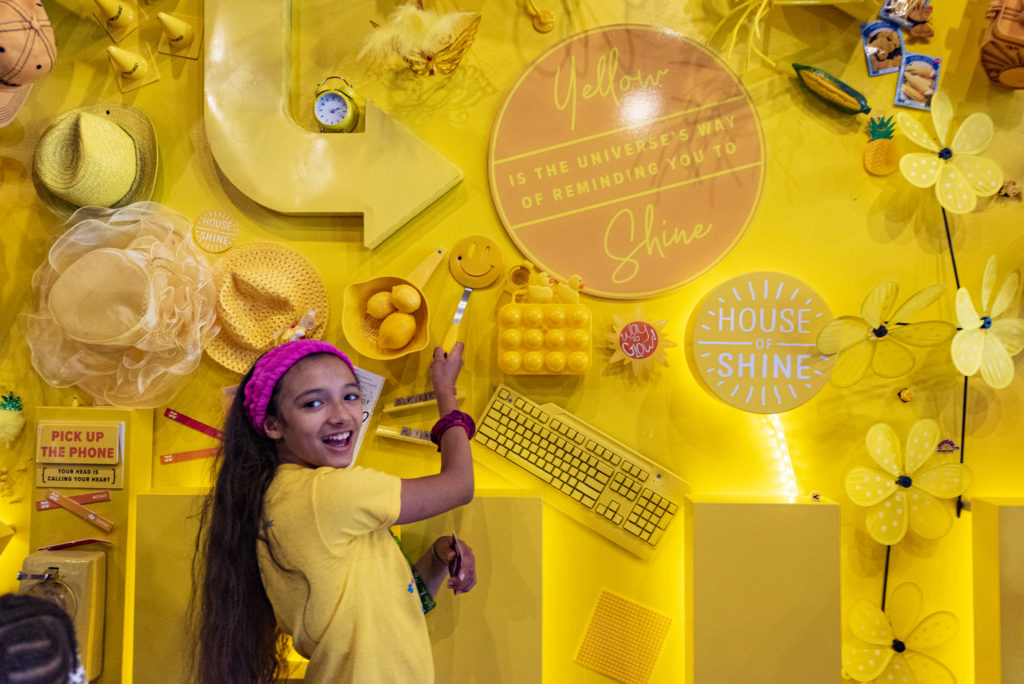
Sustainability is on the top of everyone’s minds these days. Designers and engineers work to improve mechanical systems, building facades, ecological impacts, water usage, and material sourcing. However, we don’t often hear conversations about exhibit sustainability. Exhibits often use cutting-edge technology, dramatic lighting, and visually compelling graphics to engage crowds of visitors each day. These heavily-used spaces require high-performing materials and technology systems but thankfully we can still achieve a wow-factor without sacrificing environmental consciousness.
We collaborated with a group of our exhibit design consultants on a presentation titled ’Building Sustainable Exhibits: to positively impact human health, the climate, the environment, & society’, presented by the American Alliance of Musuem’s Environment and Climate Network. This presentation was organized by CambridgeSeven Associate and Exhibit Designer Douglas Flandro who is a Certified Passive House Consultant and a LEED Accredited Professional who leads CambridgeSeven’s Sustainable Working Group. Douglas enlisted the help of CambridgeSeven Senior Associate and Exhibit Designer Sumi Fasolo, AIA, as well as the expertise of clients and designer partners (listed below) to assemble this valuable set of guidelines.
Presenters included:
Suzanne Barbati – President and Executive Director, OH WOW! The Roger & Gloria Jones Children’s Center for Science & Technology
Elizabeth Hummel –VP of Operations, Image 4
Glenn Shrum – Associate Professor of Lighting Design, Parsons School of Design
Yiannis Cabolis – Director of Technology Innovation, Electrosonic
Ryan Poe – Director of Technology Solutions, Electrosonic
How to Design Sustainable Exhibits
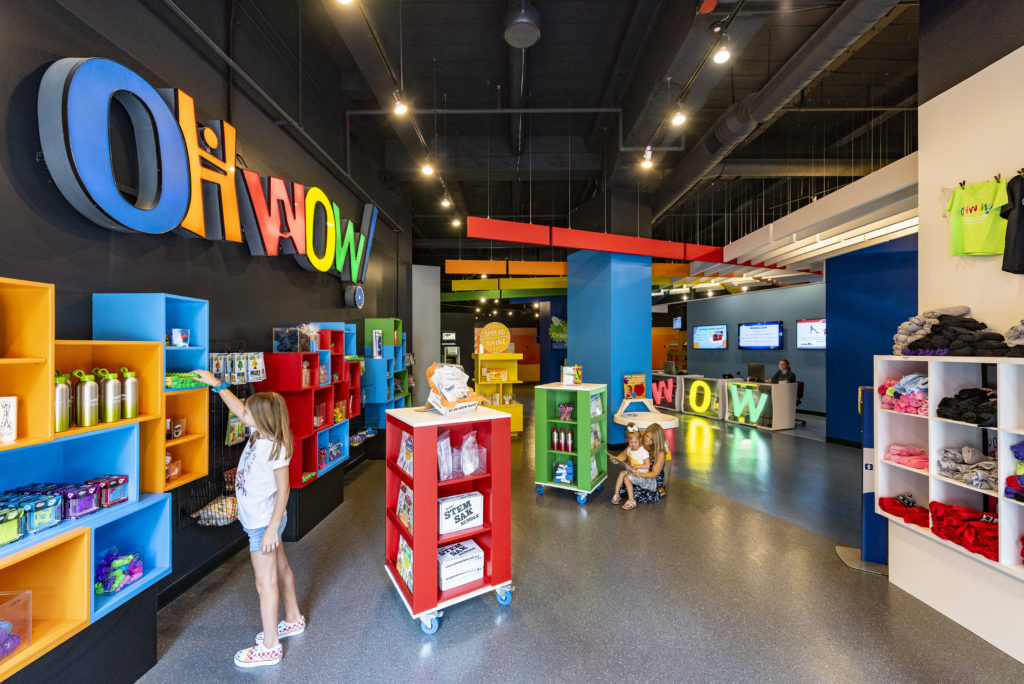
Saving Money and Resources
Presented by Suzanne Barbati
We can often achieve multiple goals at once when we design responsibly and sustainably. Suzanne Barbati of OH WOW! Science Center was on a tight budget when she hired CambridgeSeven for a recent renovation. Our team worked with the center to salvage many cabinets and exhibit furnishings to use in the new exhibit galleries. The existing exterior “OH WOW!” sign was moved inside to the souvenir shop in their redesigned entry space. Since the sign is huge and illuminated, this was a great way to ensure it didn’t go to the landfill. OH WOW! also worked with the public to bring in objects that bring them joy for a dynamic collage “SHINE” wall that teaches children about focusing on mental health. By engaging the community and creatively using what the Center already had, our teams completed the renovation on time and on budget for a successful reopening. This approach helps us see that sustainable solutions can simultaneously help save money and resources.
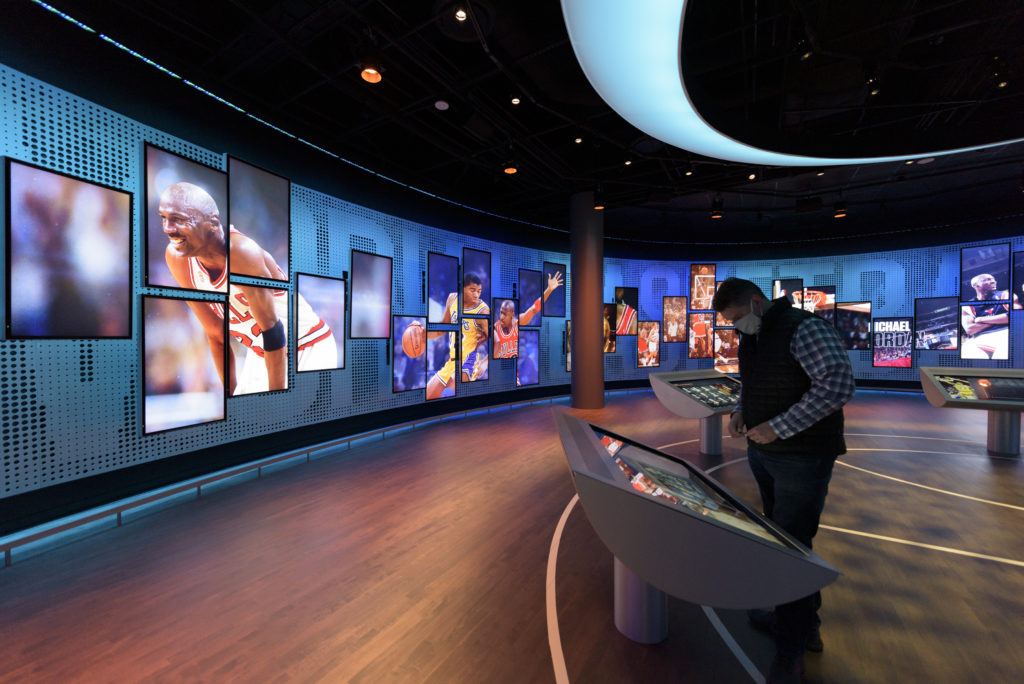
Exhibit Energy Usage
Presented by Douglas Flandro
CambridgeSeven has developed a custom digital tool to help monitor energy use in museum exhibits. Electrical engineers and lighting designers often track the Lighting Power Density (LPD) of a new exhibit space. This number calculates the maximum power used if all installed light fixtures are switched on all the time. While this is important to calculate the maximum electrical load for a building, it does not track the actual energy usage in the exhibit. Our new calculator tracks the actual usage of each fixture. This is called the Energy Use Intensity (EUI) which is the actual annual energy use per square foot. EUI is the same metric used to calculate energy use of high-performance buildings in LEED and other rating systems. Setting EUI goals for exhibit lighting and media incentivizes the use of motion sensors and lighting sensors to dim lights when not needed and reduce energy use for lighting and media. The tool also tells us how much of the exhibit’s electrical needs contribute to the entire building’s EUI.
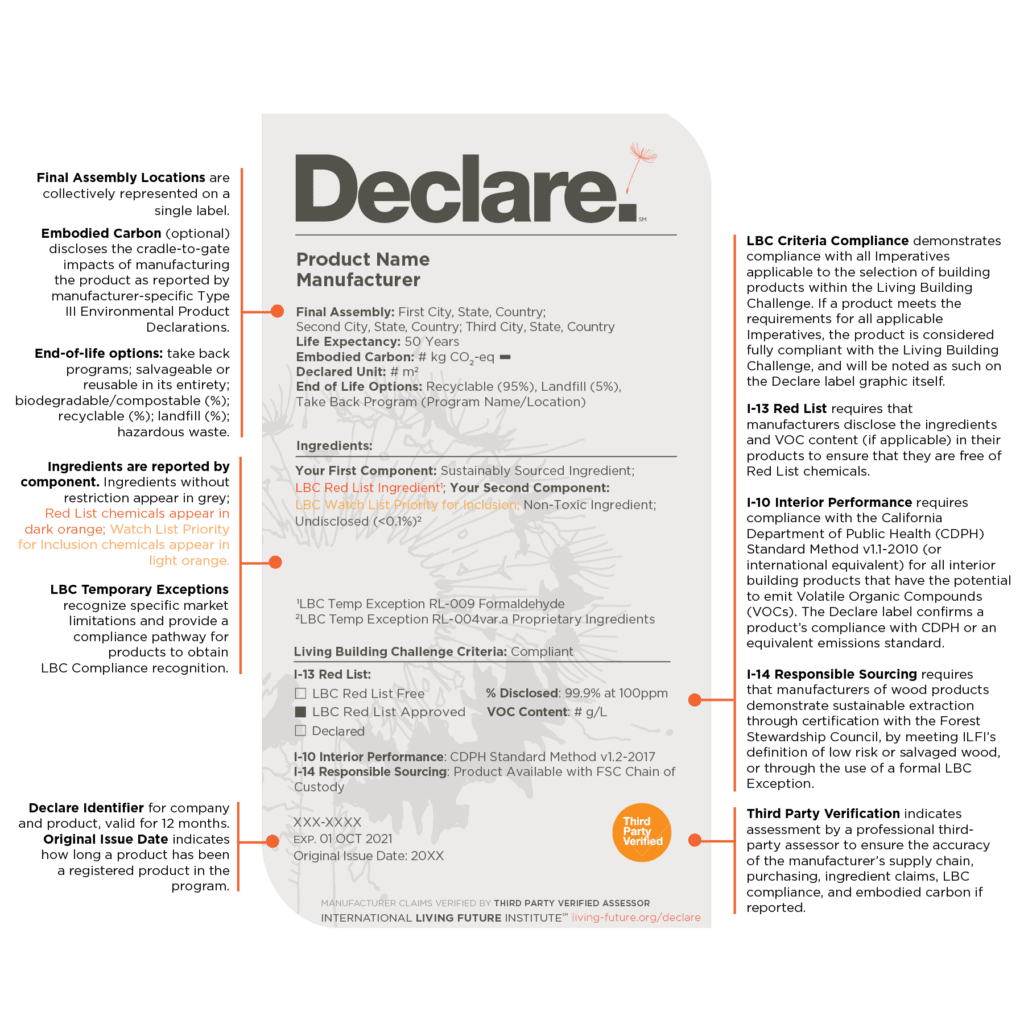
Third-Party Rating Systems
Presented by Douglas Flandro and Sumi Fasolo
Exhibit designers use a wide array of materials, finishes, and assemblies to achieve their desired visitor environments. With so many vendors and manufacturers to choose from, it can seem difficult to select responsible brands. Fortunately, there are third-party rating systems to help guide our choices. Designers can reference lists from Greenguard Institute for low VOCs and Cradle to Cradle Products Innovation Institute to find eco- and human-friendly options. Another good reference is the International Living Future Institute’s Red List, which lists chemicals and materials that should be avoided. The ILFI’s Declare label certifies products that are Red List Free.
These products avoid toxic chemicals and have been lab tested for low volatile organic compounds (VOCs). Common culprits of VOCs include paints, clear finishes, metal finishes, plywood and particle board so, it’s important that designers pay special attention to selecting these materials. Being an architect and exhibit designer, Sumi Fasolo is well-versed in specifying green solutions for polished concrete flooring, carpets, resilient flooring, wood and tile flooring, countertops and textiles. Third party rating systems for specific building materials include the Master Painter Institute’s X-Green Performance standards for paints, the Forest Stewardship Council for forestry products, and the Carpet and Rug Institute’s Green Label Plus program for carpet products.
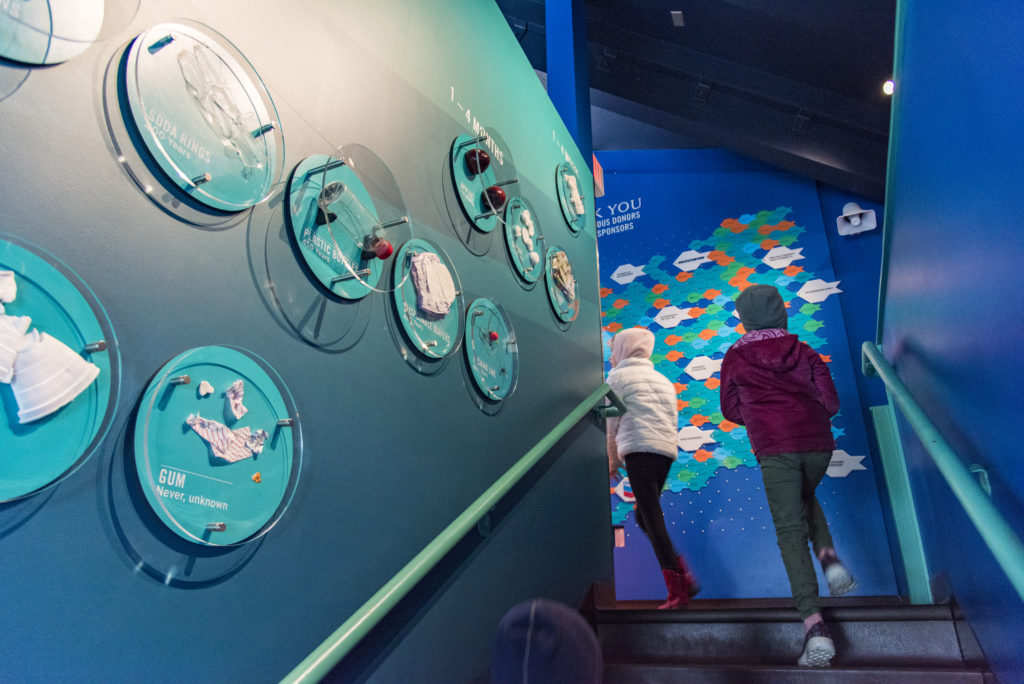
Materials & Graphics
Presented by Elizabeth Hummel
Exhibits often feature vibrant wall graphics and environmental signage to guide and inform visitors through spaces. Traditionally, these kinds of graphics are vinyl-based or printed on plastic or styrene which makes them very sturdy and likely to hold up in high-traffic areas where people will often touch or bump into the walls. To avoid plastic-based graphics, however, designers can opt for paper-based materials which are more easily recyclable.
Many inks and paints, when printed on plastics, can create chemical reactions that result in off-gassing as they release airborne chemicals and odors. Therefore, designers and fabricators should be careful about the types of inks and surfaces they specify and consider alternatives, such as fabrics instead of paints to enliven exhibit spaces.
Evaluating the environmental graphics lifecycle is also important and designers should consider whether a particular element would be in the exhibit forever; if not, would an updated graphic be required at some point and finally, how readily can any given element be disassembled or replaced.
Designing exhibit components with disassembly and replacement in mind can save a lot of time and resources down the road. Instead of using adhesives, which can emit odors and are permanent, using fasteners allows wall graphics to be easily replaced if they become damaged or outdated. It’s also a good idea to plan where these elements originate. If you anticipate replacing graphic panels often, for seasonal changes or rotating themes, you can lessen your carbon footprint by sourcing your graphic panels from a local supplier to limit their distance and time in transit.
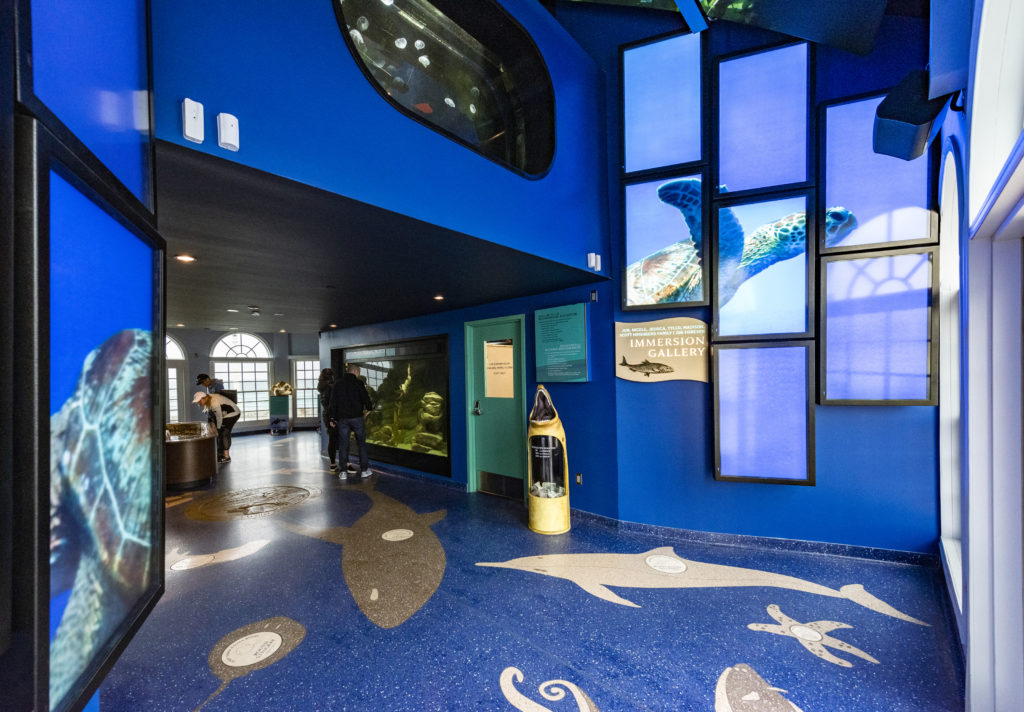
Lighting
Presented by Glenn Shrum
Lighting plays a huge role in exhibit and gallery spaces, more so now than in previous years. Beyond typical light sources like pendants, track lights, and spotlights, there are several sources of light in exhibits such as digital projections and LED screens of varying sizes. Some of these screens are even interactive, which means users get very close to them. Thinking about how to balance the user experience with energy efficiency is vital for creating successful exhibits.
Not everything everywhere needs to be illuminated all of the time. In fact, designers can use contrast to their advantage by increasing lighting to certain areas that require visitor attention, therefore, drawing attention away from darker areas. Timers and sensors that trigger lights only when users are in the space can save energy and create a more dynamic environment.
With light emitting from sources other than lightbulbs, we might actually need less illumination than we did in years past. Digital displays are increasingly common and emit ambient light that may be enough to light an entire space. When we redesigned the Roundhouse Aquarium in California, we augmented the entry sequence with a series of LED displays that emit enough lights for visitors to enjoy the space without traditional ceiling or wall-mounted lights.
Capturing daylight is usually a standard method to make buildings more energy-efficient as they need less artificial light, but this is particularly tricky for exhibits which often have very controlled and curated environments. Because daylight changes throughout the day, a morning visitor may have a very different experience than an evening visitor and the space might be too bright for the afternoon visitor. Daylight can be utilized for indirect use or as ambient lighting if it’s filtered and controlled well.
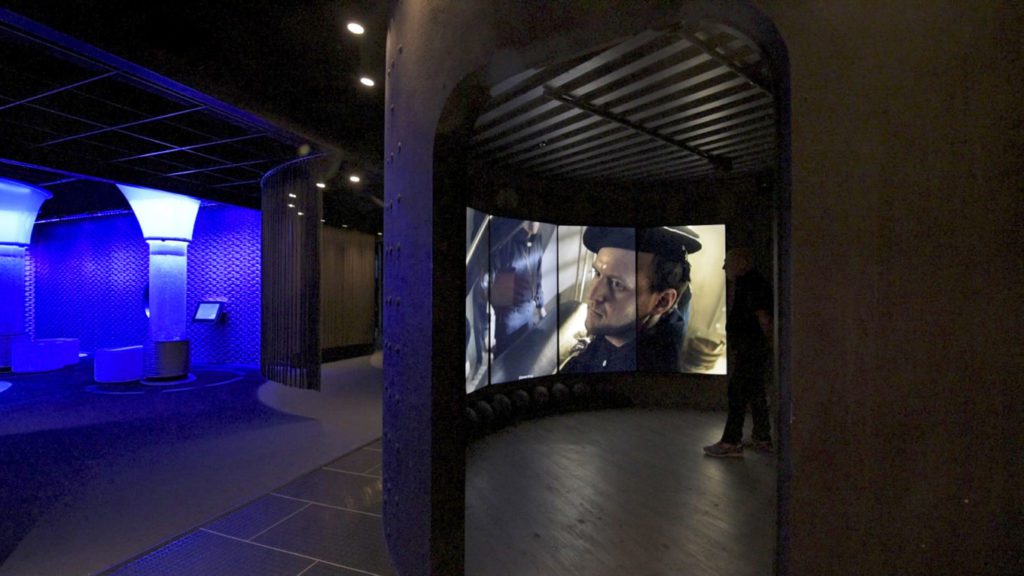
Displays and Systems
Presented by Yiannis Cabolis and Ryan Poe
A part of exhibits that we don’t often see or notice are the technology systems in place behind the scenes. Similar to how a corporate office has a server room, museums and attractions also have these central hubs that host their content, which is brought to life in the front of house. These rooms emit a lot of heat and require mechanical cooling that can be very energy-intensive. An alternative to dealing with this equipment on site is to host the content at a remote location, similar to how video streaming works – the content is hosted somewhere outside of your home, but you’re able to view it on your home computer.
Digital displays also require significant energy, especially when large, wall-filling projections are involved. But designing the space around these elements can help save energy. Displays don’t need to be as bright if they are hosted in a dark space. And while many displays are created with LED lights, an eco-conscious alternative is OLED (organic LED) materials; these are organic materials that are naturally bioluminescent.
When designing sustainable exhibits, it’s important to balance environmental concerns with human health and visitor experience. With recent advancements in technology, materials, lighting systems, and fabrication methods, designers have more options to craft their exhibits responsibly. You can see some of our recent exhibit work here for more inspiration.
To see the video recording of the webinar, click here.
This article was originally published October 28, 2021